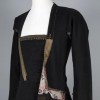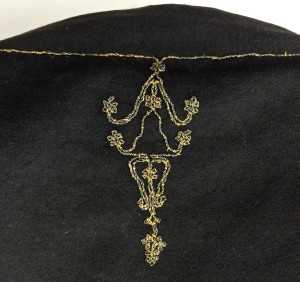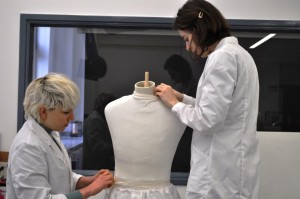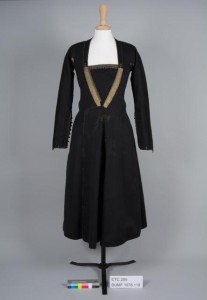
by Hannah Vickers, 1st year student, MPhil Textile Conservation.
At first glance, textile conservation can appear to be a profession purely focused on the tangible aspects of objects. But, as I have discovered, an important part of the profession is the understanding of an object’s meaning and significance.
During our first semester here at the Centre for Textile Conservation and Technical Art History (CTCTAH) we attend Material Culture lectures. This part of the course helps us to question why we preserve objects at all and analyse the different ways to understand and treat them.
In one of the assignments for the Material Cultures course, we collaborated with students from the Dress and Textiles History course to write a report on a particular object. Our group had the opportunity to research an item from Dumfries Museum – an Afghan coat with a complex history and significance. It was once owned by Colin Mackenzie (1806-81), an officer in the Indian army, who, whilst held hostage in 1841 during the First Afghan War (1839-42), was given the coat by his captor, the Afghan prince Akbar Khan (1816-45).
The outer fabric of the coat is densely-woven and fulled black wool, decorated in delicate couched embroidery in gleaming gold-wrapped thread. At the chest, decoration of a v-shaped panel edged with strips of gold embroidery tapers towards the close-fitting waist, whilst long rows of Chinese knotted buttons fasten the pointed sleeves. The coat is lined with a printed cotton and multi-coloured silk, which peeps from the edges of the collar, cuffs and slashes under the arms.

During the course of mounting the coat ready for display on Open Day, fellow student Nora Frankel and I discovered it had an unusually square cut and construction. This made the process of building up the mannequin’s shoulders to a supportive yet anatomically realistic level particularly challenging!

The coat not only gives an insight into the rich variety of materials and techniques put to use in the courtly fashion of nineteenth-century Afghanistan; it also speaks of the culture of gift-giving in the court, and of the sensitive and surprising relationship between captor and captive. No rags and shackles for Mackenzie – Khan appears to have treated his captive with great respect, assimilating him into the court with an outfit edged in silk and gold. The coat provides a glimpse into the personal relationships of two individuals at the heart of the tense and ultimately violent situation of the First Afghan War, with repercussions that continue into international politics today.
In 1911 the widow of Mackenzie gifted his coat to Dumfries Museum. In its current setting the coat represents the critical role individual objects can play in history and the interwoven cultural connections between Scotland and the rest of the world. Through our research into its history, we were able to confirm the coat was the very same one worn by Colin Mackenzie for a portrait painted on his return from Afghanistan, now in the National Army Museum.


Together, the portrait and coat add up to more than the sum of their parts, telling a richer, more tangible story than either could alone.

